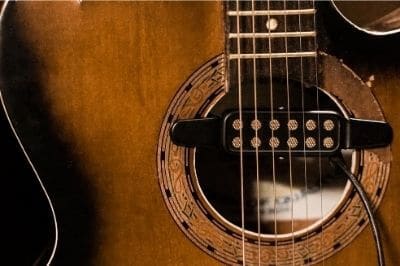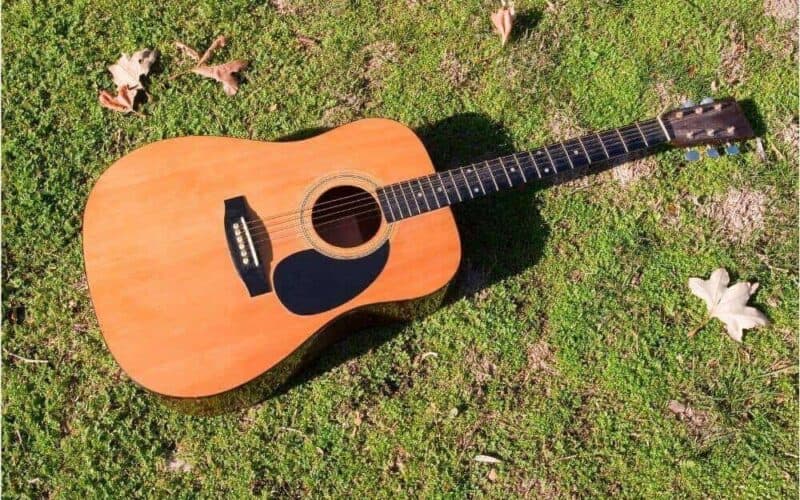The acoustic guitar is one of the instruments that produce the most beautiful tones but is less loud than an electric guitar. While acoustic guitars are built with hollow bodies that are meant to amplify their sound, this can only do so much in the overall loudness of your instrument.
If you’re performing in a large open space, we are all too familiar with the struggle of getting your guitar to produce extra volume. So in this article, we will explain to you how to make an acoustic guitar louder.
We’ve compiled some of the tested and proven ways that you can amplify the sound of your acoustic without distorting its beautiful tones.
Tip#1: Play Harder
One of the simplest ways you can increase your acoustic guitar sound is to simply play harder. This is one of the most common ways to make your guitar volume loud enough that even professionals suggest this for beginners.
When you play harder, or by exerting more energy with every strum, the string creates larger vibrations that will resonate throughout the guitar’s hollow body. This is what makes the guitar tone more powerful.
The only downside to playing harder is that it could get tiresome, especially if you’re not used to playing your acoustics that way. With enough practice, you will eventually be able to control your strumming to make both beautiful and loud music.
Tip#2: Replace Your Guitar Strings
If you’re using light nylon or steel strings, then we also suggest replacing them with heavier steel strings. These strings are known to create bolder, fuller, and louder tones, so you can make your acoustic guitar sound brighter and generate more noise this way.

Also replacing old strings with a new set can have a positive impact on the increment of sound level.
However, there are precautions that you must know before immediately getting them replaced.
First, is that not all guitars are made with truss rods that can support the neck properly in case of these heavier steel strings. Make sure to check first – otherwise, you run the risk of breaking the neck on your instrument.
Second, know that heavier gauge string requires more strength from your fingers. This may hinder playability and seem like a challenge at first, but you’ll get the hang of it eventually.
Tip#3: Play Close to the Bridge
Playing your guitar close to the bridge also helps amplify its sound. It has been tested and proven that playing acoustics close to the bridge creates a vibrant tone that is similar to that of an electric guitar.
While this may not seem like the best solution, it helps if you’re planning to go for that electric style of loudness and tone.
Tip#4: Invest in a Clip-on Microphone
One of the best ways to surely make your acoustic guitar tone louder is to get help with the latest technology. With that said, we recommend investing in a clip-on microphone that could surely amplify the volume when you play.
These clip-on microphones can be conveniently mounted near the soundhole of your guitar. This allows it to catch the vibrations which it then amplifies.
Clip-on microphones come in different styles and are available somewhere around $50 to a little over $300. Those on the more expensive side of the price spectrum are usually high-end models so you’re assured of the quality.
However, we advise getting more affordable ones if you’re just starting out – especially if you don’t plan on playing professionally.
These microphones also come in corded and cordless designs. If you love moving around while you perform, we recommend getting the cordless type. The downside is that these are normally battery-operated, so you have limited active hours.
But if you’re not a very active performer, then a corded one will do the trick just fine.
Tip#5: Check the Pickup and Volume Control
Some acoustic guitars are considered semi-electric and are known as acoustic-electric or electro-acoustic guitars. They have the pickup element that allows it to be connected to an amplifier – and from there, you can conveniently adjust the volume.

You can check if your guitar has an active soundhole pickup if it has a bar located under the strings and over the soundhole. Otherwise, you can invest in a soundhole pickup, acoustic preamp with an equalizer system & volume control that can improve the sound quality and amplify the raw signal before it goes to the amplifier.
Some musicians are opting to have professionals install a pickup on their acoustic. You can also consider this option if you’re willing to spend money to get that loud sound. But just make sure that you get a professional to do it – otherwise, you might ruin your guitar entirely.
You can check this video on how to install a soundhole pickup on an acoustic guitar if needed.
Tip#6: Change String Action
If you have set up your guitar’s action (string height from the fretboard) at very low, that would be the case of string buzz. In that case, there is a chance to increase the guitar sound by changing the string height or setting up higher action.
Heavier strings with higher action settings (not too high) will help you to get more amplified volume.
Tip#7: Use Heavier Guitar Pick
A heavier pick can generate a louder noise than a thin pick. Thicker pick made from stiff material tends to produce higher volume. This also depends on your pick’s shape & size, your picking technique, and how firmly you hold the guitar pick.

On the other hand, a stronger attack on the strings can help fingerstyle guitar players without using a pick. As a finger picker, you can also pull and release the strings to make a slight slap on the fretboard, which produces more volume.
Tip#8: Change Saddle, Bridge Pin and Nut
The saddle, nut, and bridge pins are significant parts of an acoustic guitar that are directly related to string vibration. If your guitar has those parts made of plastic, then you can simply improve your acoustics’ dull sound by replacing those plastic parts.
We suggest at first try a set of the bone saddle, nut and pins to examine whether it fits your guitar or not.
You can experiment with a combination of parts made of different materials like Bone, Graph Tech or Tusq, and Brass or Aluminium to analyze the sound produced from each element. Then determine the better material that fits well in your guitar.
Tip#9: Choose the Right Guitar
There are some acoustics with bigger bodies like dreadnaught and jumbo; those generally create more volume than guitars with other types of body shapes.
But this is not correct for every circumstance, because creating loudness does not depend only on a single factor. Guitar body shape, construction design, solid or laminate top wood, and bracing styles have an impact on producing higher volume.
As an example, we can say that cutaway guitars are quieter than standard acoustics. So if you are looking for loud volume from your guitar, then avoid cutaway design. Also, switch your acoustic with the right one to get a better sound.
Tip#10: Consider Your Surroundings
If you don’t have to play in an open area, then we suggest playing in a small enclosed area to increase the loudness of your acoustic sound.
When you play in an enclosed area, the vibrations from your guitar can bounce off of walls, and this effectively amplifies the sound. This is one of the easiest and most affordable ways to make your guitar sound better and achieve great results without using an amp.
Related Articles:
- How Much Does It Cost To Restring A Guitar?
- 13 Effective Guitar Tips For Beginners
- 12 Tips For Guitarists To Stay Focused And Motivated
About the Author
Thomas M., the founder of Guitar Top Review, boasts 15+ years of guitar experience and was a church band member in L.A. Transitioning from piano to acoustic guitar, his first love remains his Taylor GS Mini. Alongside like-minded hobbyist friends, he launched the site, driven by a deep love for music that transcends professional boundaries.


